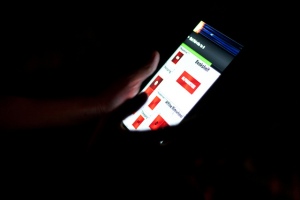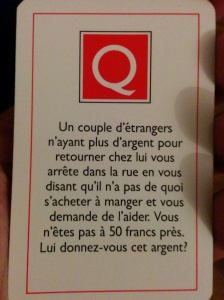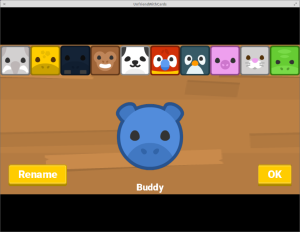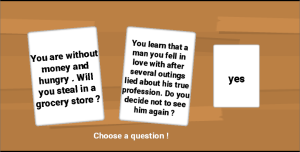So I released my last prototype on the Google Play Store and thought it was time to look back on why and how I did it.

Phase one : inspiration
I’ve always been fascinated by players interaction in video game, mostly because I’m not able to understand or predict it.
I was especially fond of a mobile multiplayer game called Space Team,
where most of the interactions happens between players and out of the screen.
Putting the focus back on player interaction and using the mobile as a tool to enhance it was something I had never seen, or though of, before.
Since I never had as much fun with any other mobile game, I naturally tried to replicate that.

Phase two : concept
To initiate player interaction I thought the most obvious way was to force them to ask questions to each others.
I didn’t want to make another clone of Truth or Dare, I added a rule where you have to guess your friend’s answer so it ended up looking pretty similar to an old board game I liked.
Since I already played the board game, I was pretty confident the end game would be fun too.
The only problem was, the core of the game relied on the quality of the questions and I’m a poor writer.
Rules
- Draw two question cards, one answer
- Choose a question
- Ask the question to a player that you expect to give the answer written on your question
- Earn points, or not, and pass the phone
Phase three : realization
As a challenge, I allowed myself two weeks to realize and publish the game. And of course it took two months…
Hang on, it’s quite long and detailed.
Content (cost : 1 night)
As said earlier, the game quality would rely a lot on the content of the questions. So why not taking the old board game’s questions ?
Since I’m a programmer I’m too lazy to type hundreds of question cards. So I just took a bunch of photos with my phone, and after some Linux magic
with a program called tesseract I had 250+ card content in a pretty JSON waiting for me ! Yum !
Net output : 250+ questions ready to be used

Working prototype (cost : 1.5 weeks)
The code basically took one week and a half to produce a fully working prototype. Since I used Libgdx which is a library I know quite well know, it was really straight forward.
I used free asset from the usual suspect Kenney and bam ! A game in two weeks ! Or is it ?
At that point I had a couple of bugs here and there, a lot of redundant scenes.
For instance a scene where you had to manually draw the cards from decks, where you could sort your hand of cards and more.
After a few playtests with friends and colleagues, it appeared it was really worthless. It just broke the pace and added nothing but confusion.
Net output : A working Android application displaying cards
Removing extra stuff (cost : 1 week)
Surprisingly, removing the extra scenes and mechanics took me almost as long as creating the prototype in the first place.
Since I was rushing the code during the first week or so, I couldn’t result the urge to refactor everything this time. It was certainly not
the fastest way, but at least I knew it would make further modifications easier.
Net output : A less cluttered Android application

Gamify (cost : 2 week)
Another outcome of the playtests was that the prototype also lacked everything that makes a game : menus, sounds, avatars what-have-you. Adding that extra set of features took me
another 2 weeks.
At that point I went very close to becoming the famous feature creep. Facebook sharing ? Of course ! Why not local multiplayer ? And why not using players facebook photos as avatars ?
While a lot of ideas were good, I remembered this was supposed to be a two weeks projects and I was already one month in…
Net output : A raw Android game
Polish (cost : 2.5 week)
Animations, transitions, particles sounds and even vibrations! I took two week to add all this little stuff that makes a game more alive.
I expected it to be way faster, how long can it be to add a simple animation to your avatar ? It’s a matter of minutes isn’t it ? It is ! But what I
forgot to take into account was the time it takes to make it look right. Trying different animations, asking different persons for feedback, rewriting that part of a scene so its more convenient.
Net output : A better looking Android game

Instructions (cost : 2 week)
At that point the game was quite close to its final version, but I was the only one able to play it because nobody
(except the few kind people who helped playtesting it) knew how to play it. It took me around 3 days to make all the tutorial code working, and more that a week
to finish it. Why ? Because I never asked myself those questions :
- When is the right time to inform the player ?
- What is the right wording ?
- How can I make this info shorter so people actually read it ?
Net output : A playable Android game

Monetization (cost : 1 day)
When I was about to put the final touch to the game and finally publish it, I thought bout monetization. Since the game was not big
enough to justify an upfront cost, nor an IAP, I chose to go the advertisement way. Using the adMob/adSense SDK was surprisingly
straighforward and easy. So I jumped onto the occasion and put an ad on every new player’s turn. A single playtest was enough to notice
it was way too much, and even usual players refused to play. Fortunately, admob allows you to control the maximum frequency of ads
from their web interface, so I had’nt to make another build.
I never made any research about how much an advertisement campaign could yield, and I was a bit disappointed to discover
the answer : not much. After a few weeks on the store and around a hundred downloads, I didn’t reach the $1/1euro milestone.
Net output : Half a coffee worth of money for pissing off my players
Lessons learned from a two week prototypes
- Doubling estimations for a project works only if you don’t double the scope with it
- When estimating a project’s duration, don’t think “it would take X weeks to code” because the code is actually the easiest part
- Playtesting help. Playtesting earlier prevents wrong choices earlier
- Think about monetization early, and no monetization is a choice, and may be better than a poor one
Conclusion
I plan on letting the app live on the store for a while. I have several improvement in mind
(the first one would be to proof-read the questions more thoroughly) that I will make if I feel it becomes worth it.
I will also disclose more numbers about downloads/revenue after toying a bit with advertisement rate so hopefully, other
devs don’t make the mistake of believing in ads as a way to monetize a low-popularity game.

And of course, if you feel like trying it and giving me some feedback, you can have a look at the
Google Play page and ping me !
